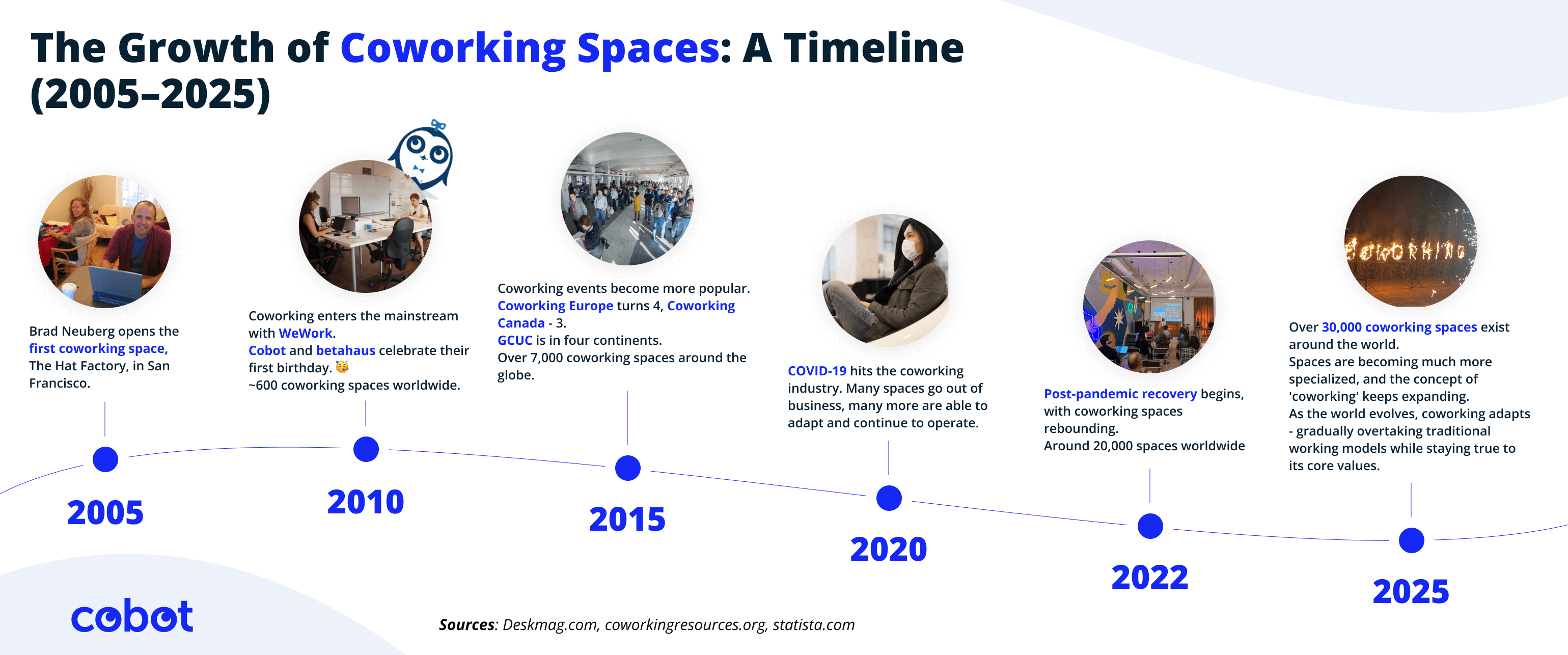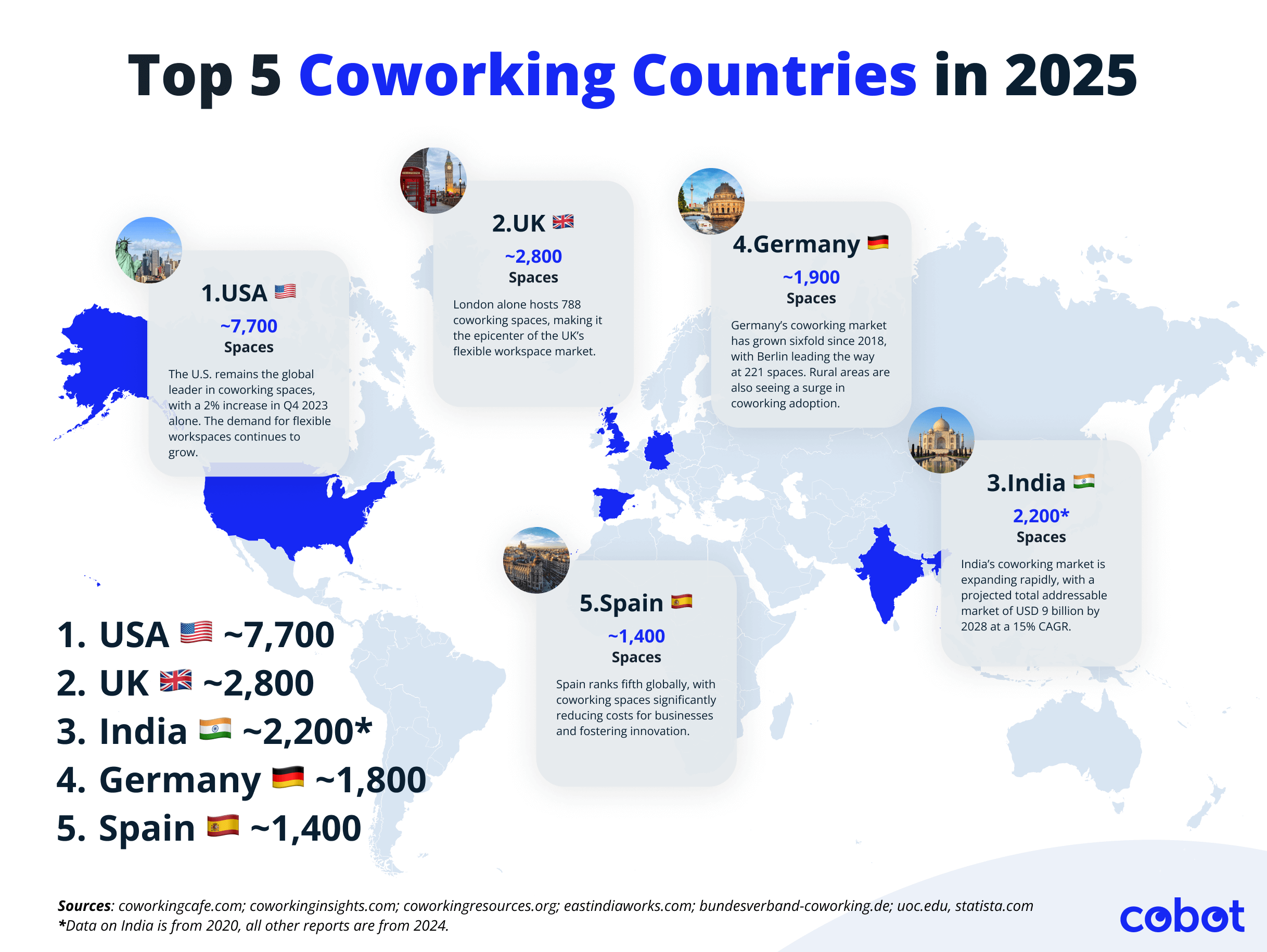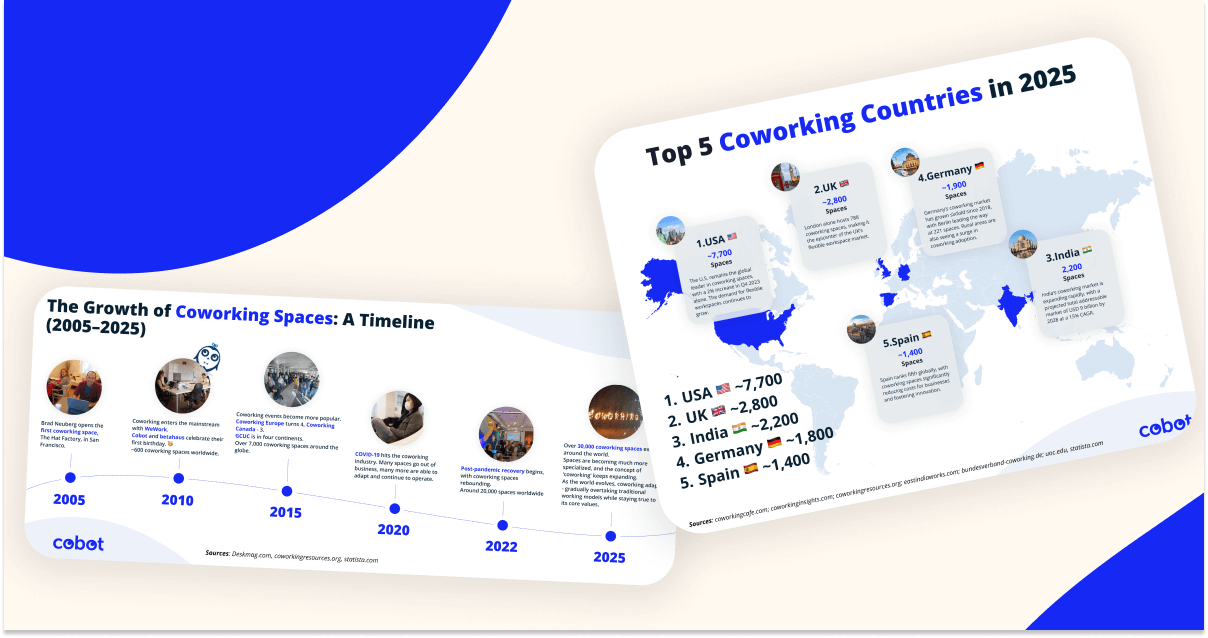Coworking has come a long way from its grassroots beginnings to becoming a global force shaping the future of work. What started as a small movement has grown into an industry that now supports freelancers, remote teams, startups, and enterprises alike.
As we celebrate 20 years of coworking, it’s the perfect time to reflect on where we started, where we are now, and what lies ahead. To put this journey into perspective, we’ve also prepared infographics showcasing how coworking spaces have grown and evolved over the years - along with a snapshot of the world’s leading coworking markets today.
The Origins of Coworking
The coworking movement can be traced back to 1995, when C-Base, a hackerspace in Berlin, created an open environment for collaboration. The term "coworking" itself was coined in 1999 by Bernard DeKoven, though it wasn’t associated with physical workspaces.
The modern concept of coworking as we know it today was born in 2005, when Brad Neuberg founded the first official coworking space in San Francisco. This small, community-driven co-op was ahead of its time - offering shared desks, WiFi, and group activities. Though it lasted just a year, it laid the foundation for today’s coworking spaces. That same year, St. Oberholz in Berlin became one of the first cafes to embrace remote work by offering free WiFi and a laptop-friendly environment.
By the late 2000s, coworking gained momentum across Europe and North America. In 2009, betahaus Berlin emerged as a pioneer of European coworking, setting a new standard for flexible workspaces. That same year, Cobot was created as an internal tool to help manage co.up, a coworking space in Berlin.
Coworking’s Growth Over the Years
The early 2010s marked the coworking boom. Spaces multiplied rapidly, attracting freelancers, startups, and independent professionals. By 2010, coworking had grown enough to establish International Coworking Day, and WeWork launched - bringing large-scale coworking into the public eye.
By 2019, the number of coworking spaces worldwide had reached 26,000, with over 3 million members. Spaces evolved to cater to niche communities, from tech startups to wellness-focused coworking hubs.
The Growth of Coworking Spaces: A Timeline (2005–2025)

If you are interested in learning more about the history of coworking, you can head over to our full History of Coworking article.
Coworking in 2025: Where Are We Now?
Coworking is now a key part of the modern work environment, and the numbers show steady growth:
📌 30,000+ coworking spaces exist worldwide (Statista, Gitnux).
📌 Europe has 6,850 coworking spaces, with a 4.7% annual growth rate (Statista).
📌 Research from digital coaching provider Ezra anticipates that by 2025, America will be leading the coworking revolution, with an estimated 6.3 million people working from shared spaces. (Newsdirect)
📌 The global coworking market is booming, projected to grow from 23.35 billion in 2024 to 27.64 billion in 2025, a growth rate of 18.4%! (The Business Research Company)
Beyond the numbers, at the end of last year, Coworking Europe 2024 offered valuable insights into where the industry is headed in 2025:
- Flex offices are expanding, attracting larger teams and enterprises.
- Independent spaces remain essential, providing niche services and local connections.
- Hybrid work is shaping coworking memberships, with companies offering employees flexible workspace access instead of traditional offices.
- Sustainability is a priority, with eco-friendly coworking initiatives becoming the norm.
📖 Want to learn more? Read the full insights from Coworking Europe 2024 here: Flex Office Dominates Discussion, Small Spaces Enrich Communities
To this day, Cobot continues to be an active part of this ever-evolving movement, helping spaces worldwide manage their operations, automate workflows, and build thriving communities.
Top 5 Countries for Coworking Spaces in 2025

Cobot in Coworking
Coworking has always been more than just shared desks, it’s about creating ecosystems where collaboration, flexibility, and accessibility thrive. What started as a solution for a single space has evolved into Cobot, the first comprehensive coworking management platform, now supporting over 600 spaces worldwide.
At Cobot, we’ve grown alongside the industry, helping operators navigate challenges and unlock new revenue streams. From independent coworking hubs to large coworking networks, we've supported spaces with the tools they need to adapt.
Navigating Challenges Together
The COVID-19 pandemic reshaped coworking overnight. Spaces had to quickly adapt to new health regulations, hybrid work trends, and financial uncertainty. In response, we introduced membership pauses, flexible billing options, and automated access control to help operators navigate these transitions smoothly.
To support coworking spaces in complying with hygiene standards, we also introduced vaccination status tracking and tools for communicating space availability and safety measures.
Additionally, we provided essential resources like Reopening Your Space Post-COVID and Keeping Your Community Connected During COVID-19, offering actionable strategies for safe reopening and remote engagement. Our expanding integration ecosystem helped spaces maintain operations and continue delivering value to their members during uncertain times.
Empowering Coworking Spaces Today
As coworking spaces reopened, we focused on supporting safe, flexible, and sustainable growth. We introduced new features like External Bookings to simplify renting out space, and team management tools to accommodate hybrid and corporate memberships.
But we didn’t stop there. From drop-in passes to event ticketing, our goal has always been to help coworking spaces expand their revenue streams while reducing administrative work. Whether it's managing memberships, automating billing, or improving accessibility, we continue to refine Cobot to meet the evolving needs of coworking operators.
Cobot grows alongside the industry, providing the technology operators need to thrive in an ever-changing workspace landscape.
The Future of Coworking: What’s Next?
Looking ahead, coworking will continue to evolve in response to new work trends and technological advancements. Some key shifts we expect to see include:
- More independent spaces: The rise of small, community-focused coworking spaces.
- Hybrid work integration: Companies using coworking memberships throughout urban areas, instead of a single traditional office lease.
- AI and automation: Smarter tools to optimize space management and enhance user experiences.
- Sustainability initiatives: More eco-friendly coworking designs.
- Industry-specific coworking: Tailored spaces for different professions and industries.
Final Thoughts
Coworking has redefined how people work, collaborate, and connect. From its grassroots beginnings to its global influence, the industry has constantly evolved to meet the needs of modern professionals.
With over 30,000 coworking spaces worldwide, the movement is stronger than ever. As we enter the next chapter, one thing remains clear:
Flexible, community-driven workspaces are no longer a trend - they’re a fundamental part of how we work.
Explore how Cobot can support your coworking space
💡 Book a quick demo and see how we can help you manage your space efficiently and effortlessly.
Happy coworking 🥳



